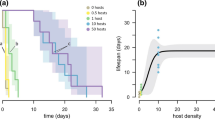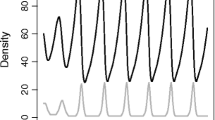Summary
Among parasitoids which host-feed destructively, there is a tendency for females to partition their feeding and oviposition behaviour in relation to different host stages, feeding preferentially or exclusively on earlier host stages and ovipositing preferentially or exclusively in (or on) later ones. We explored the dynamic implications of this behaviour for parasitoid-host population dynamics, using modifications of the age-structured simulation models of Kidd and Jervis (1989, 1991).
Using the new versions of the models, we compared the situation where parasitoids practice host stage discrimination with respect to feeding and oviposition, with the situation where they do not. Additionally, we examined the effects of host stage discrimination on populations by (a) having generations either discrete or overlapping, (b) varying initial age structure, (c) having varying degrees of density dependence acting on host adult mortality, and (d) varying parasitoid develoment times in relation to the length of host development.
With either discrete or overlapping generations of the host population, a reduction in the parasitoid development time had a destabilizing influence on the parasitoid-host population interaction. With discrete generations stage discrimination had no effect on the risk of extinction, irrespective of either the degree of density dependence acting on the host population, or the initial age structure of the host population. When parasitoid search was uncoupled from the insect's adult energy requirements, the interaction was always unstable. With continuous generations, stage discrimination affected stability at certain parasitoid development times, but not at others. The relative lengths of parasitoid and host development times also influenced the tendency of the host population to show discrete or overlapping generations.
Similar content being viewed by others
References
Askew, R. R. (1971)Parasitic Insects. Heinemann, London.
Clausen, C. P. (1940)Entomophagous Insects. McGraw-Hill, New York.
Godfray, C. J. and M. P. Hassell (1989) Discrete and continuous insect populations in tropical environments.J. Anim. Ecol. 58: 153–174.
Hussey, N. W. (1985) Whitefly control by parasites. 104–115. In N. W. Hussey and N. Scopes (eds).Biological Control: the Glasshouse Experience. Blandford Press, Poole.
Jervis, M. A. and N. A. C. Kidd (1986) Host-feeding strategies in hymenopteran parasitoids.Biol. Rev. 61: 395–434.
Kidd, N. A. C. and M. A. Jervis (1989) The effects of host-feeding behaviour on the dynamics of parasitoid-host interactions, and the implications for biological control.Res. Popul. Ecol. 31: 235–274.
Kidd, N. A. C. and M. A. Jervis (1991) Host-feeding and oviposition strategies of parasitoids in relation to host stage.Res. Popul. Ecol. 33: (in press).
Mackauer, M. (1982) Fecundity and host utilization of the aphid parasiteAphelinus semiflavus (Hymenoptera: Aphelinidae) at two host densities.Can. Ent. 114: 721–726.
Murdoch, W. W. (1989) The relevance of pest-enemy models to biological control. 1–24. In M. Mackauer, L. E. Ehler and J. Roland (eds)Critical Issues in Biological Control, Intercept, Andover.
Murdoch, W. W., R. M. Nisbet, S. P. Blythe, W. S. C. Gurney and J. D. Reeve (1987) An invulnerable age class and stability in delay-differential parasitoid-host models.Am. Nat. 129: 263–282.
Nettles, W. C. (1987)Eucelatoria bryani (Diptera: Tachinidae): Effect on fecundity of feeding on hosts.Environ. Entomol. 16: 437–440.
Neuenschwander, P. and E. Madojemu (1986) Mortality of the cassava mealybug,Phenacoccus manihoti Mat.-Ferr. (Hom., Pseudococcidae), associated with an attack byEpidinocarsis lopezi (Hym., Encyrtidae).Mitt. Schweiz. Ent. Gesell. 59: 57–62.
Sahragard, A., M. A. Jervis and N. A. C. Kidd (1991) Influence of host availability on rates of oviposition and host-feeding, and on longevity inDicondylus indianus Olmi (Hym; Dryinidae), a parasitoid of the Rice Brown Planthoper,Nilaparvata lugens Stål (Hem; Delphacidae).J. appl. Ent. (in press).
Author information
Authors and Affiliations
Rights and permissions
About this article
Cite this article
Kidd, N.A.C., Jervis, M.A. Host-feeding and oviposition by parasitoids in relation to host stage: Consequences for parasitoid-host population dynamics. Res Popul Ecol 33, 87–99 (1991). https://doi.org/10.1007/BF02514576
Issue Date:
DOI: https://doi.org/10.1007/BF02514576




